The 30 best animal encounters around the world for every kind of animal lover
Science
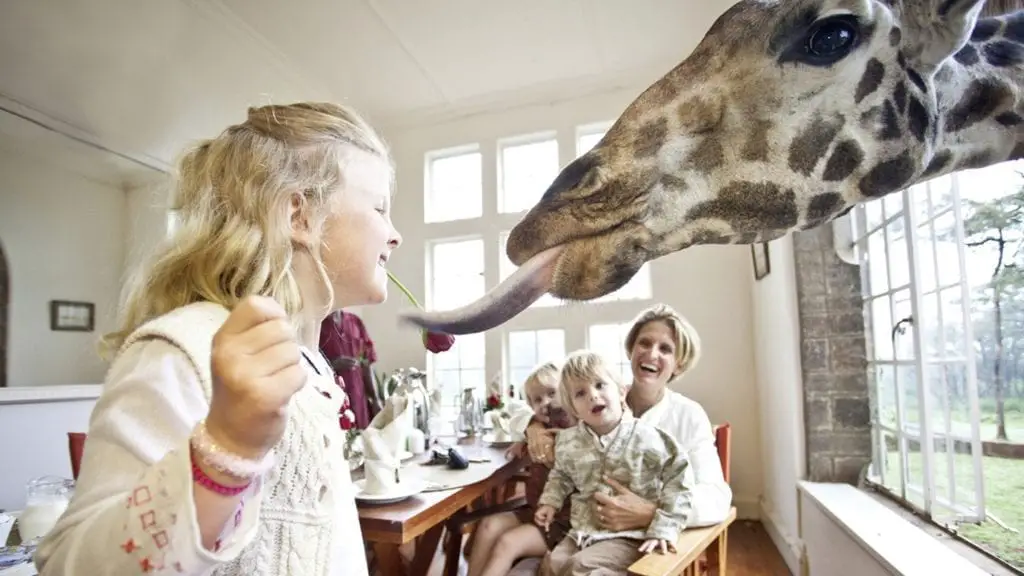
1. Live among giraffes at Giraffe Manor
Family Traveller
Are you an animal lover who wishes you could get a little bit closer than the zoo lets you? Well, you should sign right up for one of these close up animal encounters. Whether you’re looking for something wild, or a little bit more controlled, there’s an adventure for you. Plus, some of them even help advance science and conservation.
If Downton Abbey took place in Africa, it would be at Giraffe Manor. The beautiful ivy-covered brick hotel looks like it belongs in a quaint English town until a giraffe sticks its head through one of the windows. Surrounded by forest in Kenya, Giraffe Manor will make you feel like an elegant Lord or Lady while you feed wild giraffes and enjoy afternoon tea.
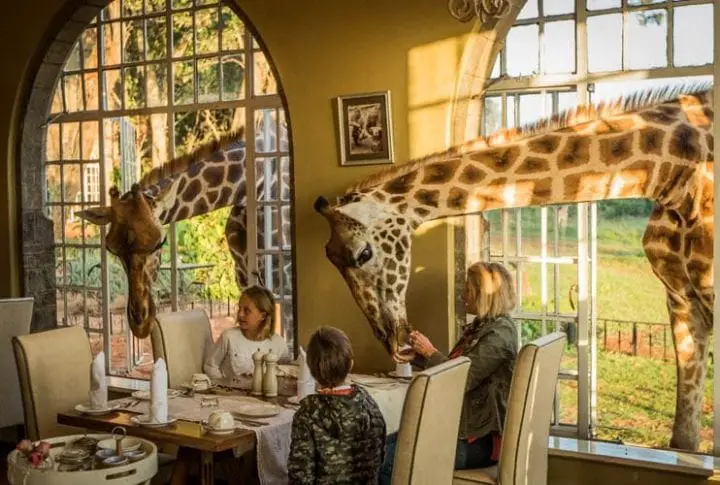
The Safari Collection
Heck, old-time English Lords and Ladies probably had their own giraffes to feed because who cared about animal welfare back then. The area around Giraffe Manor is a sanctuary for the endangered giraffes, who come and go as they like. Depending on which room you choose to stay in, the price starts around $600 per adult sharing a room.
2. Walk with polar bears in the Arctic
If you’ve ever dreamed of seeing a polar bear in the wild, head over to Churchill, Canada. It’s on the edge of Hudson Bay and home to the largest polar bear population on Earth. Churchill Wild has comfortable eco-lodges and offers a variety of walking polar bear safaris.
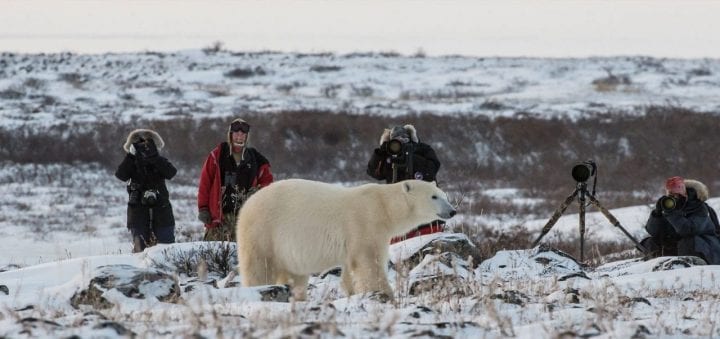
Churchill Wild
On the safari, you’ll ride around in a vehicle looking for polar bears. Then, once you or the guide spots them, you’ll get off and approach on foot. The guides instruct you on how to approach and where to stop before you get too close. The bears are wild animals, so there’s no fantasy-inspired bear riding or cozy snuggling, but you can get pretty close to the polar bears.
3. Swim with pigs in the Bahamas
On an uninhabited island in the Bahamas, you can make all your wildest dreams come true by swimming with pigs. You have to get there by boat, but there are plenty of tour companies willing to take you. It’s not clear exactly how the pigs got to the island, because they aren’t native, but they are there to stay (since people are now making sure they do).
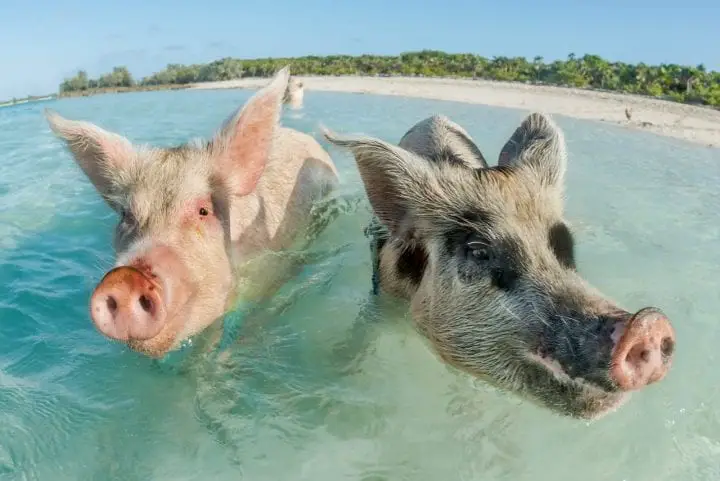
bearacreative/iStock
You can feed the pigs, but it’s best to do that in the water and not on the beach to avoid letting the pigs eat sand. Not far from Pig Beach, on a different island, is the local Fowl Cay Resort. It’s comfortable and beautiful, but expensive, so there are other hotel options nearby.
4. Trek to see a mountain gorilla family in Uganda
Join guides for gorilla trekking to see the critically endangered apes in Uganda’s Bwindi Impenetrable Forest. There are a few different lodges you can stay at, including Silverback Lodge and Gorilla Forest Camp. Before you go, though, you need to get a gorilla trekking permit, which can be bought through your safari agent.
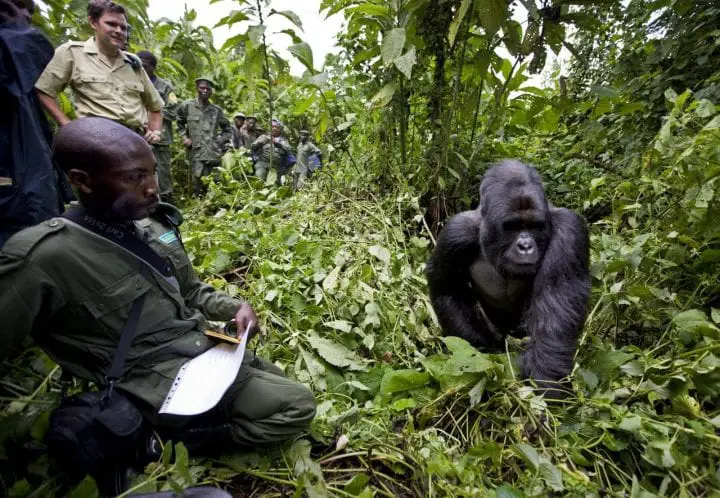
Brent Stirton/Getty Images
Once in Uganda, you’ll hike through the forest and possibly even tea plantations, looking for gorilla droppings and listening for baboon barking. Both indicate gorillas are nearby. You might get so close you can touch them, and most of them are habituated to humans already, but you’ll probably be told to keep your hands to yourself.
5. Feed a giant panda in Chengdu, China
Since you missed your chance at being the official Baby Panda Cuddler at the Giant Panda Protection and Research Center, you may as well visit and get a taste of what you could have had. At the Chengdu Research Base of Giant Panda Breeding, you can watch pandas up close and learn all about the adorable bears.

VCG/Stringer/Getty Images
Plus, you can spend a day as a panda keeper by cleaning their enclosure, hand feeding them, and, the cutest of all, making cakes for them. Only a psychopath wouldn’t want to make cakes for pandas. Throughout the visit, the staff will teach you all about panda conservation, so you can leave a better human than you were when you went in.
6. Cage dive with great white sharks in South Africa
If you haven’t seen “Jaws,” you might be entertaining the idea of cage diving with sharks. Well, there are a variety of places to do it, but White Shark Projects boasts the most contact with the “gigantic sentient torpedos” as they lovingly call the sharks. To begin your time at sea, the ship’s crew will make a scent trail to attract the sharks toward the water’s surface.
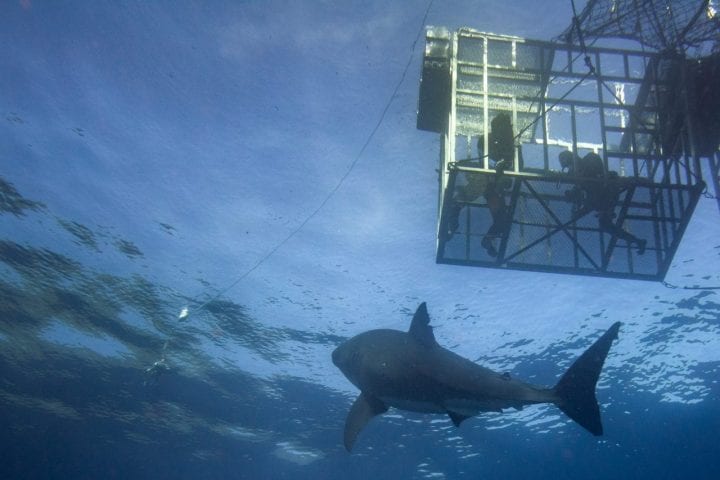
izanbar/iStock
Then, you’ll be treated to the stomach-dropping sight of the iconic fin sliding through the water toward you. At long last, you’ll get your equipment on and climb into the cage to be lowered down into the water to watch the show. White sharks love this area because of the thousands of seals living nearby.
7. Meet wombats, koalas, and feed kangaroos in Australia
If you’re going to Australia and want to hang out with animals, but not risk your life in the wild, you can visit Caversham Wildlife Park. There, you meet wombats that look like furry potatoes, feed Australia’s iconic kangaroos, meet the equally iconic koalas, and feed little penguins.
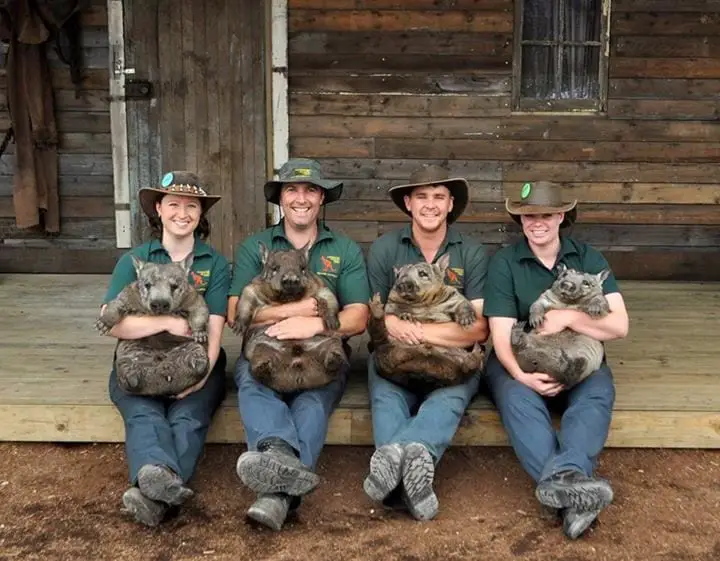
Caversham Wildlife Park
The park’s admission is $29 for each adult, but it does include all the interactions and feedings. And while you’re smiling over the goofy-looking wombats, perhaps you’ll get a chance to look at their cube-shaped poo! It’s been a scientific mystery for ages that was recently solved: their stretchy intestine shapes it.
8. Howl with wolves in Washington
At Predators of the Heart animal sanctuary, you can meet a wolf pack, go on a walk with two of them, and learn all about wolves. You’ll get to touch them and howl with them in the beautiful Pacific Northwest forest. The encounter costs $200 per person and you can book it through Airbnb.
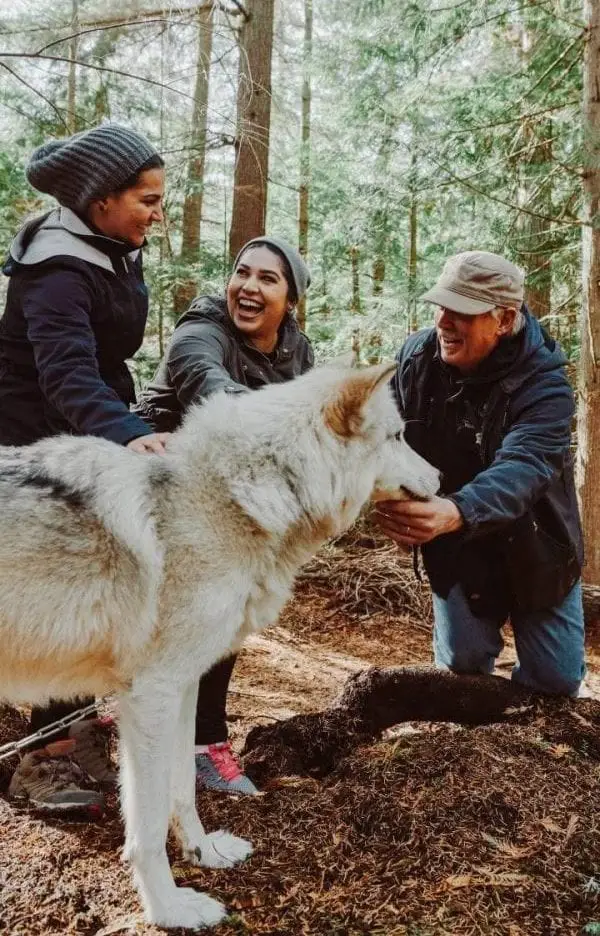
Predators of the Heart
The sanctuary has more than just wolves; it’s also home to cougars, foxes, reptiles, birds of prey, and others. To be safe around the wolves, you have to abide by their dress code: no leather, furry, or fluffy clothes. You don’t want to entice the wolves.
9. Ride, bathe, and feed elephants in India
The Dubare Elephant Camp in India is home to elephants that once worked in logging for the Forest Department. They’re retired now and live in the camp surrounded by forest. During your visit, you can bathe the elephants, feed them, and even ride them. As anyone retired will tell you, getting baths is the best part.
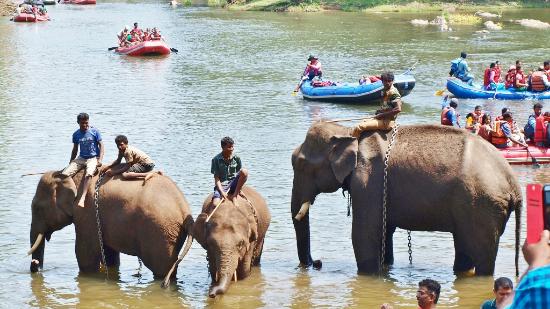
TripAdvisor
When visiting, you can do just a single day trip or spend the night if you want, enjoying meals and nature walks on top of the elephant interactions. There are plenty of other animals living around the area and there are bird watching opportunities. Plus, the naturalists on staff will teach you all about elephants.
10. Snorkel with humpback whales in Tonga
Off the shore of a small island in the Pacific Ocean, and out of range of the United States’ laws about swimming with marine mammals, you can frolic with humpback whales. In the waters around Tonga, humpback whales mate and give birth to their young, staying there for several months at a time.
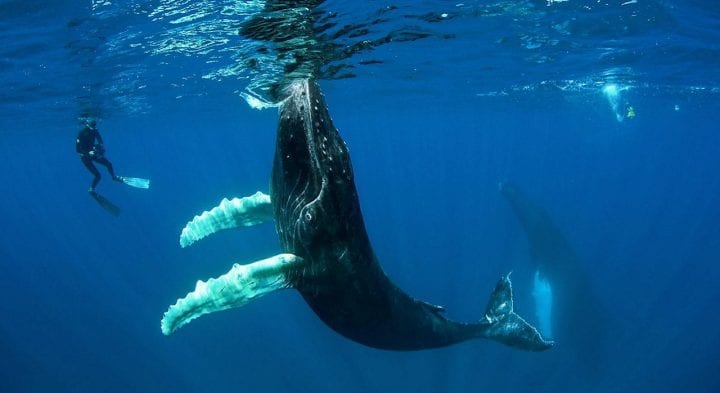
Wilderness Travel
You’ll have to go between June and November because the whales come up from Antarctica for the summer. You can book a trip through Humpback Swims, which starts at $3,300 for a five-day trip, including housing. They say October is the best month to interact with whale babies, which are up to 15 feet long when born!
11. Meet unique reptiles at the Galapagos Islands
Famous for leading Darwin to the theory of evolution, the Galapagos Islands are largely uninhabited by humans and heavily managed to conserve the unique species living there. But, with careful planning, you can visit the islands and those unique animals. Fly in from Ecuador and stay in either a hotel or on a cruise ship.
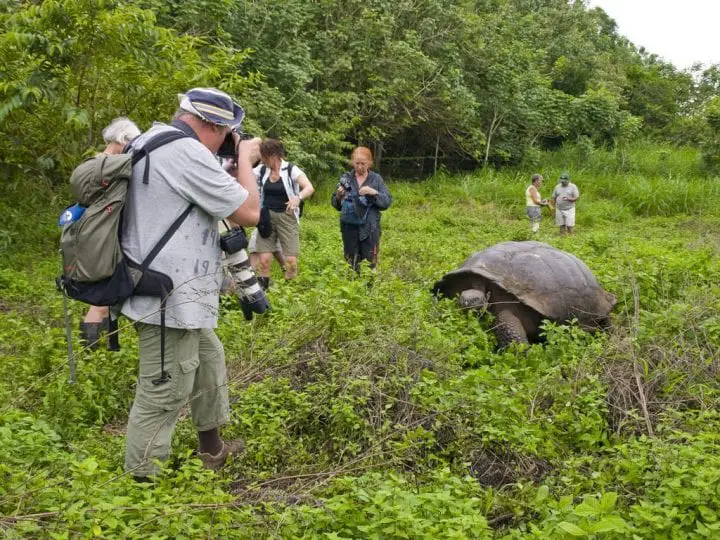
galapagosodyssey/Flickr
There are few predators on the islands, so many of the animals are friendly and curious about people (especially the sea lions). There are albatross, penguins, hammerhead sharks, whale sharks, and Pacific sea turtles on the islands. But two of the most exciting species are the Galapagos tortoise and the marine iguana, so you’ll have to check them out.
12. Hold a domestic fox in Southern California
Decades ago, Russian scientists decided to try and domesticate foxes as past humans domesticated wolves to make dogs. It was a scientific experiment in which they continually bred the foxes that were friendliest to humans. Years later, they achieved it. They sold some as pets and some made their way to Southern California.
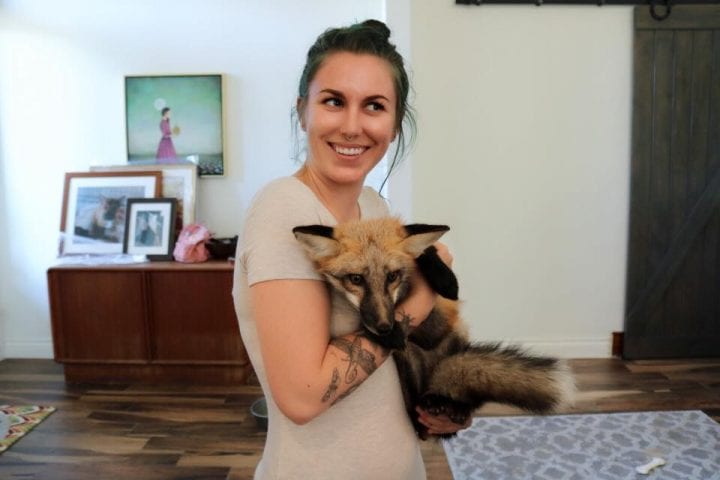
SiberianCupcakes
JAB Canid Education and Conservation Center is home to several of these domestic foxes from the experiment and you can visit them for the price of $150 for two people. At the center, you can get up close to the adorable foxes and even hold them. Finally, all your exotic pet dreams can actually come true, because science.
13. Chill with stingrays in the Cayman Islands
If you’ve ever wanted to meet the golden retrievers of the sea, aka stingrays, head over to Stingray City, a group of sandbars off the Cayman Islands in the Caribbean. The friendly stingrays will come right up to you, looking for a treat.
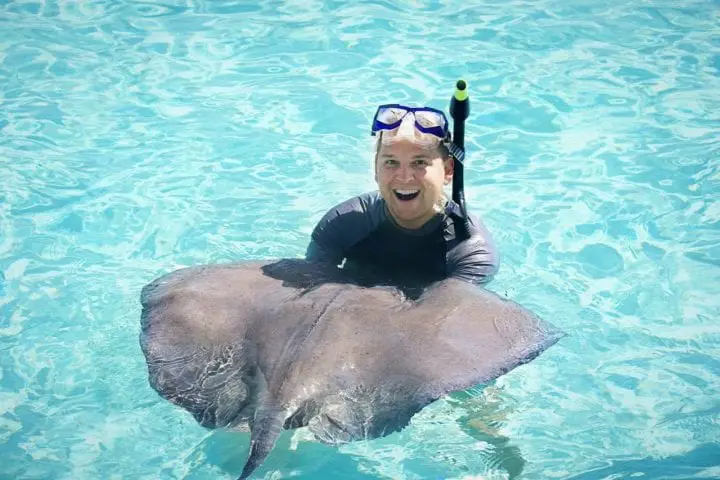
Yobro10/iStock
You can feed them and pet them, as long as you mind their stingers. The boat trip to Stingray City costs $40, but you’ll also have to pay for your hotel and accommodations while in the Caymans. While you’re in the area, you can also snorkel and dive to see a shipwreck-turned-reef, colorful fish, and intricate corals.
14. Snorkel with whale sharks off the coast of Mexico
From August to November, you can swim with the largest fish in the sea: the whale shark. They spend those months off the coast of Mexico, which is one of few places on Earth that whale sharks are regularly seen. You have to go during this time period, though, because the whale sharks mysteriously disappear throughout the rest of the year.
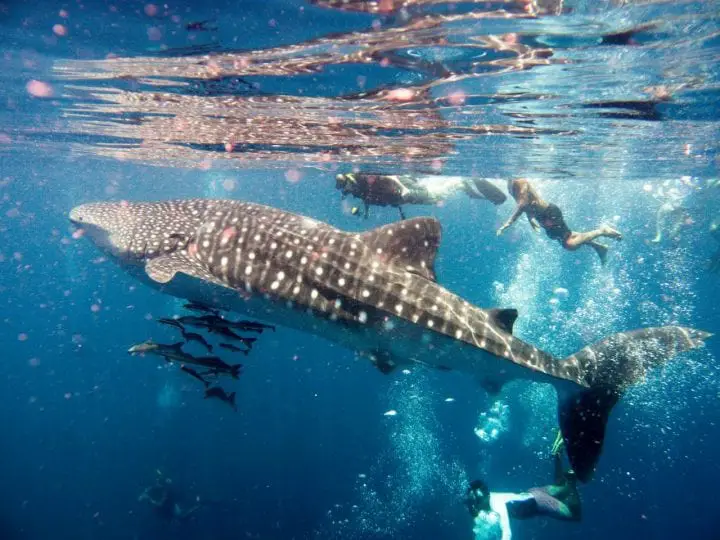
Placebo365/iStock
To get to the sharks, you can take an all-inclusive six-day trip from San Diego to the eco-lodge for $2995 with Baja Airventures. When you’re not snorkeling with whale sharks (who are actually really hard to keep up with), you’ll be looking for whales, sea turtles, and manta rays. Plus, you can swim with sea lions and go bird watching.
15. Watch brown bears hunt in Alaska
You know all those photos of bears ripping into a freshly caught salmon? They were taken at Katmai National Park, which has one of the largest populations of brown bears in the world. They go to the Brooks River each summer to feed on salmon. You can take a day trip from Anchorage to the river via plane or you can stay a couple of nights.
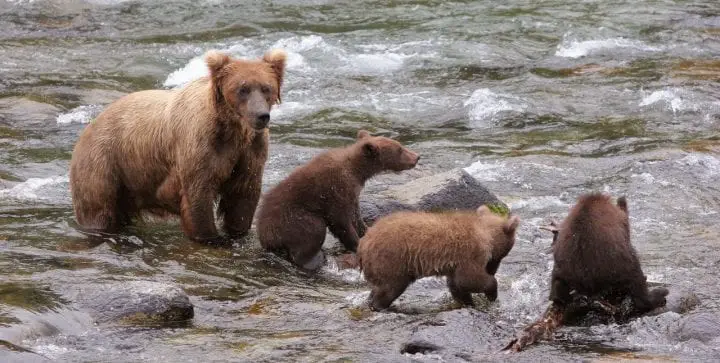
jcrader/iStock
There’s the main waterfall area where most people view the bears, but if you’re looking to get away from the crowds you can take a guided tour elsewhere in the park. There will probably be many brown bears at once in the area, splashing in the water and grabbing delicious salmon.
16. Scuba dive with manta rays in Southeast Asia
If you’re an animal lover who’s also interested in science, the Ray of Hope expeditions may be just right for you. On the trip, you’ll team up with the “Queen of Mantas” — one of the leading manta ray researchers in the world — to monitor manta ray populations and engage in conservation efforts.
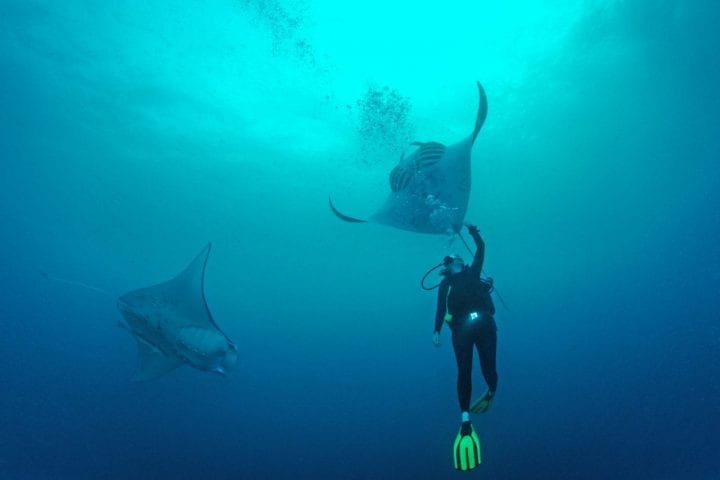
Global_Pics/iStock
When you’re not diving with manta rays, you can kayak, lounge on beaches, listen to research talks, set camera traps, and a variety of other activities. However, while most of these animal encounters are fine for inexperienced adventurers, this manta ray expedition is geared toward advanced divers.
17. Swim with wild dolphins in Hawaii
Sure, you can go swim with dolphins at SeaWorld, but it feels a lot more special when they’re wild dolphins hanging out with you of their own free will. You can swim with wild dolphins in a variety of places by hopping on a boat and looking for a pod, but to make it easier, you can book a boat tour to guide you.
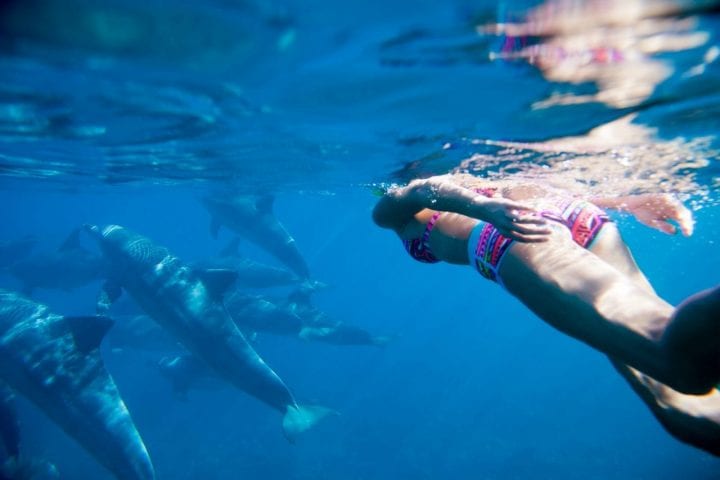
Casarsa/iStock
Wild Side Hawaii offers a boat tour for $195 per person, on which you can swim with wild dolphins, see a variety of whales, and possibly snorkel with sea turtles. Since all the animals are wild, there are no guaranteed sightings, but they are highly likely to happen.
18. Volunteer with cheetahs in South Africa
While paying to do hard work may seem ridiculous, there’s probably no other way to get as close to cheetahs as you will by volunteering at Cheetah Experience in South Africa. You have to apply well in advance, but you don’t need any prior experience and the cost includes living accommodations for the duration of your visit.

Matt/Cheetah Experience
On a typical day, you’ll be preparing food for the animals, assisting with educational tours, making structures and toys for the animals, walking the cheetahs, and possibly caring for young animals. For a week, it costs about $412. If you’re a student, you could apply to one of their internships, which are cheaper than regular volunteering.
19. Get up close with orangutans in Borneo
If you’re looking for an encounter with one of our closest relatives, the orangutan, look no further than Sepilok Rehabilitation Center. They take in orphaned orangutans, some of which were pets, and give them a lush rainforest home. The center is on a protected reserve, so many of the orangutans are free to wander as they please, while the others are cared for in nurseries.
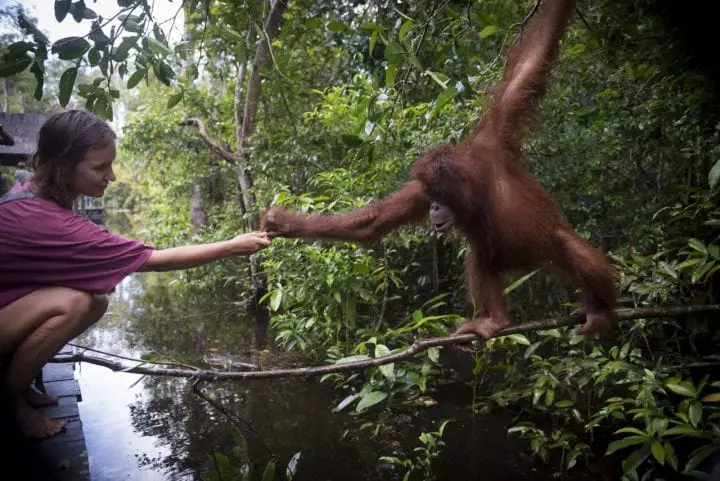
Joel Carillet
Some of the orangutans find their own food in the rainforest preserve, but the staff offers one free meal of banana, papaya, bamboo shoots, and other fruits per day. All three orangutan species are critically endangered, so this is probably the only place you can get this close to them.
20. Hang out with penguins in Antarctica
If you’re willing to brave the awful smell, you can head over to Antarctica to see penguin colonies. You’re not technically supposed to approach them closer than 16 feet, but if you’re patient and quiet, they might come to you. The wild penguins might jump in your lap, peck your pants, or rub against you.
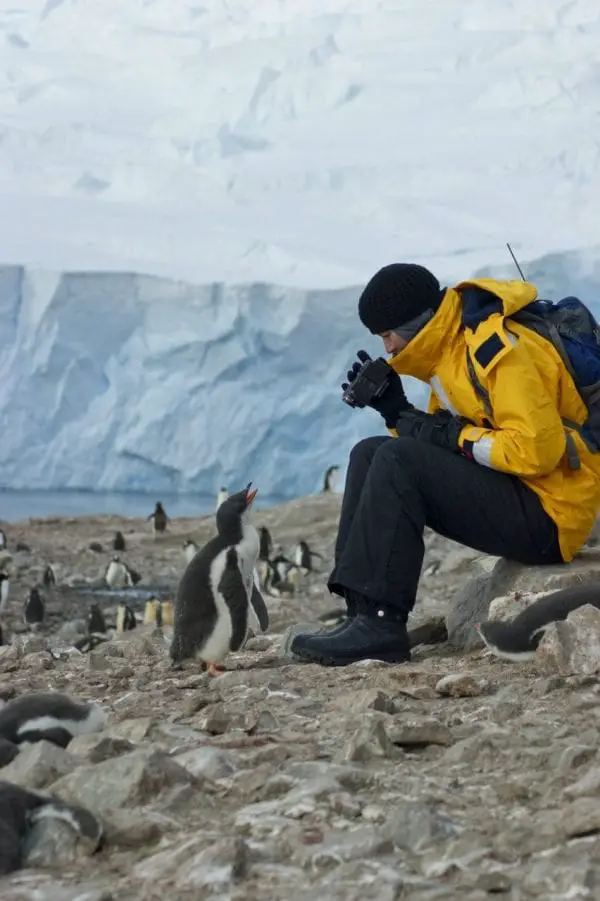
Bkamprath/iStock
Nine different species of penguin live in Antarctica, so you’re bound to have fun with at least one of them. To get there, you can join Quark Expedition (for the small price of $9,000+), who will fly and boat you around on your expedition. Along the way, you might also see albatross and elephant seals.
21. Splash with a river otter in Georgia
If you’ve ever seen an otter, you’ve probably been brought to your knees by how adorable they are. However, I bet you haven’t had the chance to see one up close. Well, don’t worry, the tiny little North Georgia Zoo is there to help you out. You can book a spot to swim with an otter and even let it sit in your lap.
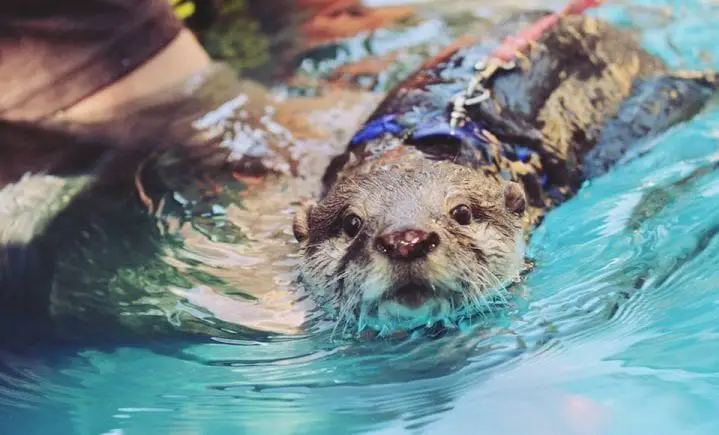
North Georgia Zoo
If you’re heartless and otters aren’t your thing, they have a variety of other animal encounters you can sign up for. There are unbelievably soft kangaroos to pet, a fennec fox to hold, and a precious sloth to feed. She might even fall asleep while you’re giving her apples.
22. Surround yourself with exotic birds in Brazil
At the Parque das Aves in Brazil, you find yourself surrounded by colorful, exotic birds like toucans, macaws, and parrots. The aviaries are large and lush, like you’re in an actual rainforest. In fact, when they constructed the park, they didn’t cut down a single native tree on site.
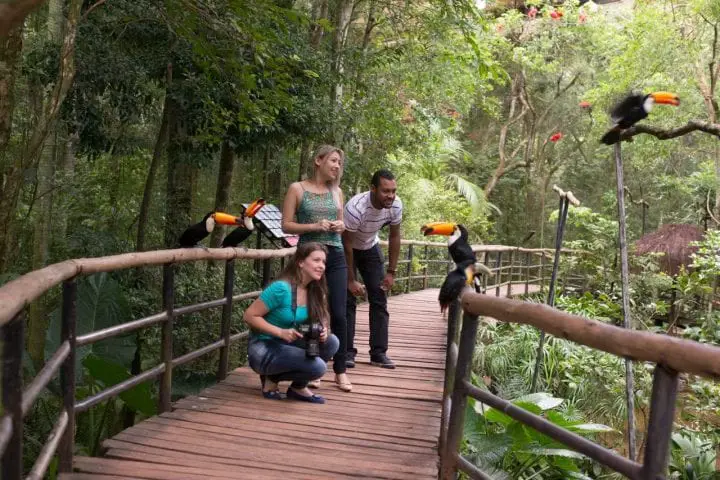
Parque Das Aves
So if you don’t want to hack your way through a natural rainforest for the chance to see birds from (probably) far away, you can take a stroll through this park to see them up close. Tickets to the park are only about $12, with which you’ll get to see the baby bird room and a harpy eagle.
23. Find wild koalas in South Australia
If you’re less interested in seeing captive koalas, you can explore Mikkira Station in South Australia. The site has a forest of manna gum trees, a type of eucalyptus, that koalas live in and munch on. You have to book a private tour to go looking for the koalas, since it is private property.
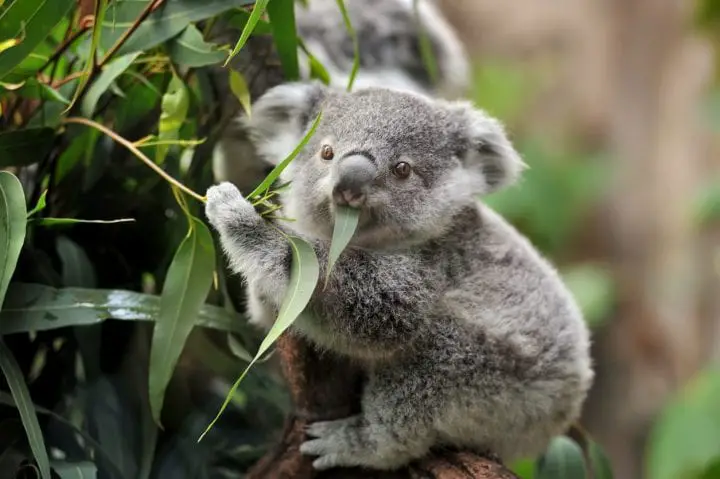
Freder/iStock
Koalas sleep a lot, so on your little safari, you’ll probably find them curled up against a tree trunk. If you’re not near Mikkira, you can also visit Kangaroo Island to see wild koalas. Along the way on both trips, you’ll probably be able to see a bunch of other Australian animals, like emus and kangaroos.
24. Canoe with moose in Canada
Perhaps you thought the best way to see wild moose was in the forest? Nope. It’s by canoe. They like to eat aquatic plants and are strong swimmers. With Voyageur Quest, you can take a three-day camping trip in Algonquin Park, Ontario to see moose in their natural habitat.
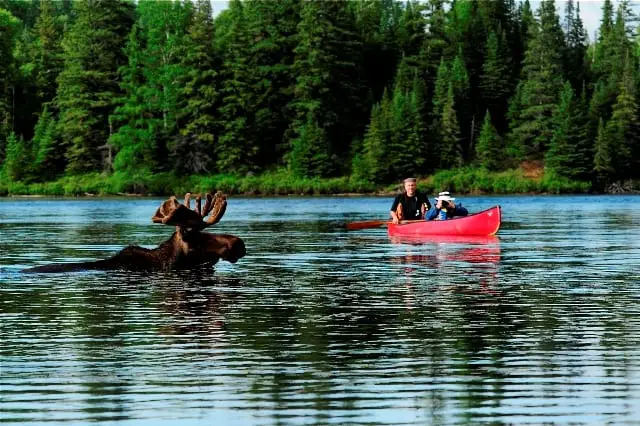
Voyageur Quest
First, you’ll practice paddling silently, so as not to spook the moose. Then, you’ll start your canoeing, camping, moose-spotting adventure. If you’re quiet enough, you’ll be able to get close to the moose without them even noticing you. Other than your 10 person group, there will probably be no other people around.
25. Save leatherback sea turtles in Costa Rica
Leatherback sea turtles are vulnerable to extinction because they face danger from humans harvesting them and their eggs, developing and polluting their habitat, and changing the climate. If you want to spend your vacation helping out this species instead of hurting them, you can join researchers with Earth Watch in Costa Rica.
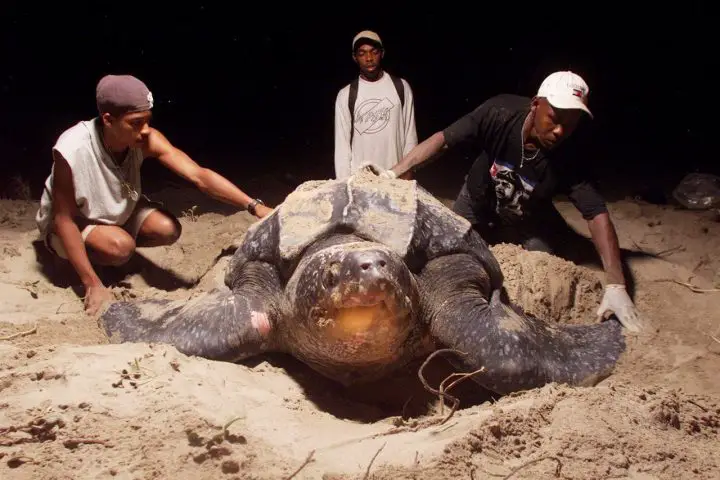
Max Trujillo/Stringer/Getty Images
The scientists are gathering information about the leatherbacks to figure out how to help them, so on the trip you’d take measurements and observations of the turtles. Depending on the time of year, you’ll probably have to move their nests out of danger or, the best part, carry the baby turtles to the (relative) safety of the water.
26. Rehabilitate baby bats in Australia
There are many different animal encounters you can do that also have a good impact, plenty of which that can be found on Animal Experience International. One they offer has you volunteering at a bat rehabilitation center. They get hundreds of injured and orphaned bats between October and February.
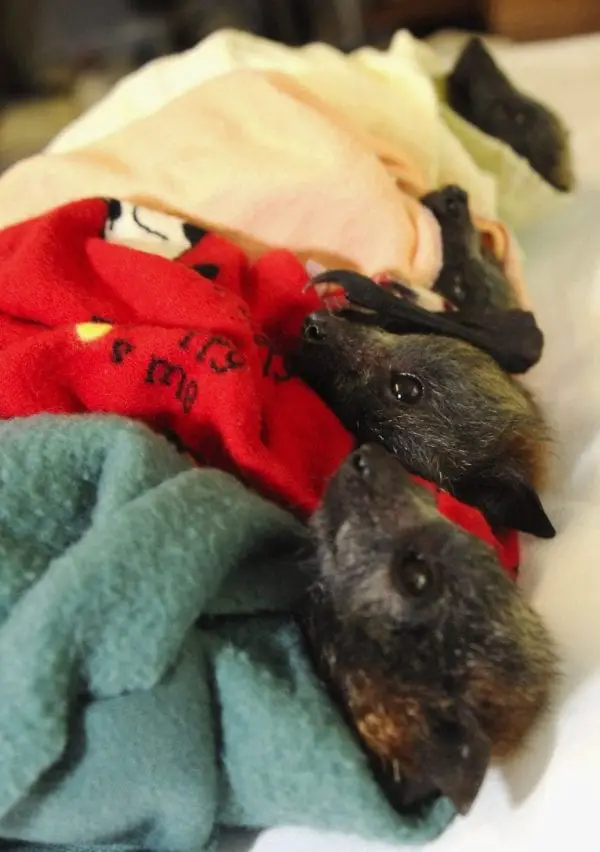
David Hardenberg/Stringer/Getty Images
At the center, you’ll help with cleaning, making food, feeding the bats, assisting with releasing them, and a variety of other duties. It’s hard work because the babies need a lot of attention, but it’s rewarding once you get to release a bat back into its natural habitat. The cost of $1320 for a week includes your luxury tent and food.
27. Kayak with beluga whales in the Arctic
From June to September, 57,000 beluga whales gather in Canada’s Hudson Bay (not far from the polar bears in Churchill). To see them, you can take a boat out to whale watch and listen to their chirps and whistles with a hydrophone, or jump in a kayak to get an even closer look.
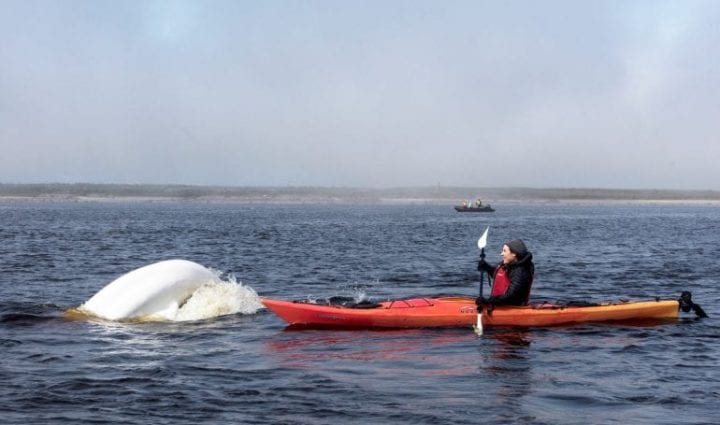
Renato Granieri
The belugas might swim directly under your boat or surface right next to you; they’ll probably play in the waves your kayak makes. To see these white lumpy potatoes (you can’t deny beluga whales are oddly shaped), you can book a trip with Lazy Bear Lodge for $434, with Sea North Tours for $88, or another tour company, depending on what sort of experience you want.
28. See the “Big Five” on an African Safari trip
African lions, African leopards, African elephants, Cape buffalo, and rhinos make up the “Big Five,” because they were highly prized by hunters for the danger it took to catch one. Now, instead of hunting them, it’s better to take a safari trip to see the amazing animals of Africa.
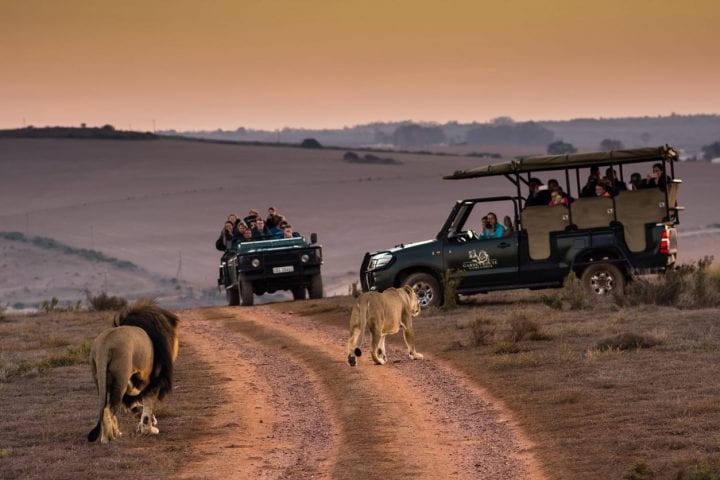
bradleyhebdon/iStock
You can go to South Africa, Kenya, Tanzania, Namibia, or Botswana to see all the Big Five. Plus, along the way, you might see giraffes, cheetahs, or hippos. Africa just has so many cool animals to see, you can’t go wrong. Just don’t get too close to the Big Five, because they were officially labeled dangerous for a reason.
29. Meet sloths, feed flamingos, and more at Busch Gardens
Busch Gardens in Tampa Bay, Florida is home to more than 12,000 animals and has a variety of ways for you to get up close to them. You can meet sloths and aardvarks, feed flamingos and giraffes, and go behind the scenes of their animal care center.
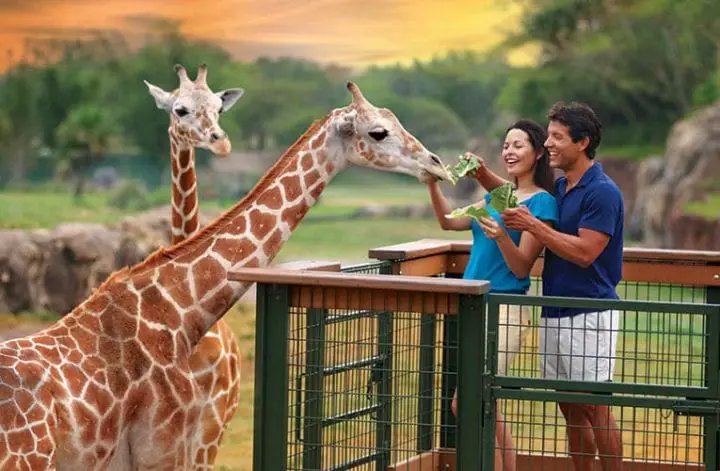
AAA Wisconsin
In the animal care center, the veterinarians do X-rays, surgeries, and other treatments on sick or injured animals so you might get a chance to watch it all. If you can’t make it out to Africa for a truly wild safari, you can visit Busch Gardens’s own (man-made) Serengeti Plain. It will have a similar vibe without the long-distance travel.
30. Encounter all kinds of animals in San Diego
There are plenty of options for animal encounters if you’re looking for something less wild. For example, the renowned San Diego Zoo has an Animals in Action Experience for $109. It’s a different experience each time, but you’ll be able to feed, touch, or help train animals.
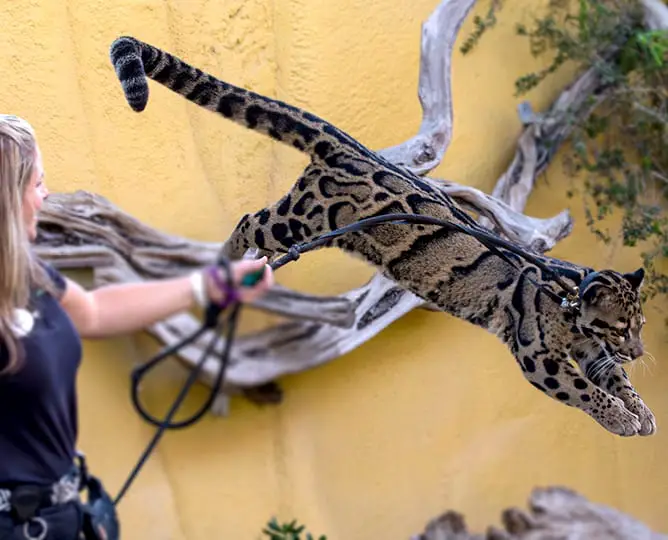
San Diego Zoo
A few encounters you might have are petting sloths and zebras or feeding flamingos and rhinos. Plus, you can get close to cheetahs and other exotic cats. The zoo has a variety of other “upgraded experiences” like an early morning with pandas and behind-the-scenes tours. If you’re into photography, they have morning tours for you.